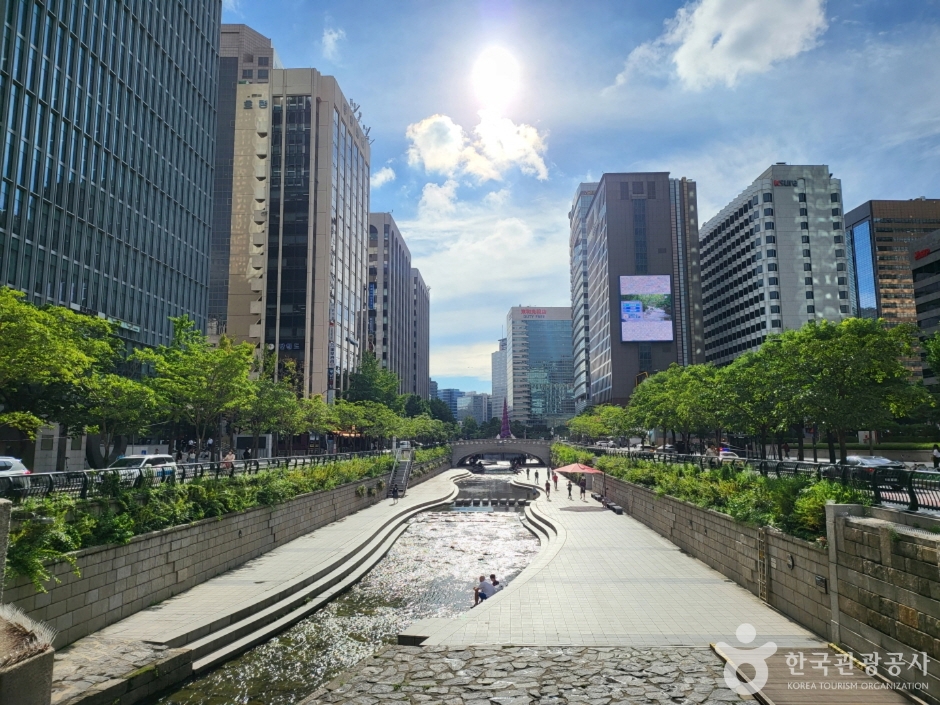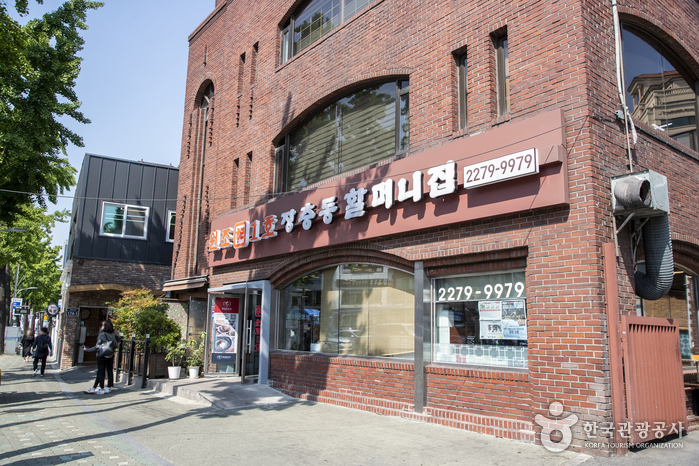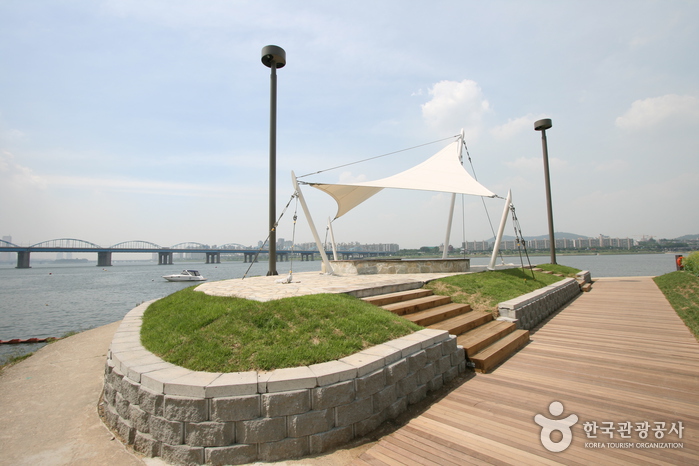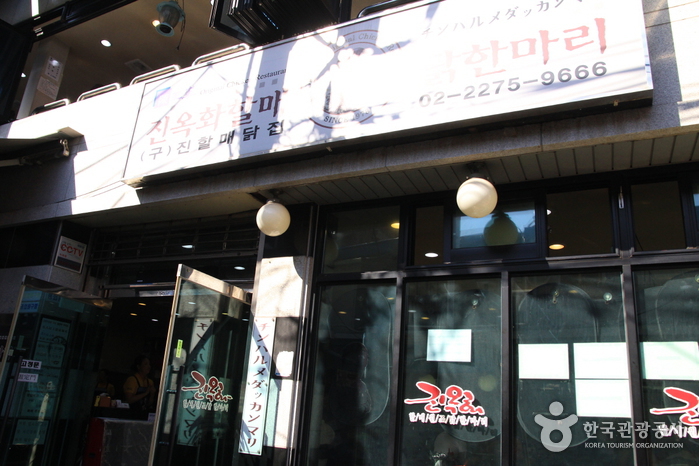Teatro ARKO (아르코예술극장)
14.4Km 2025-09-15
Daehak-ro 8-gil 7, Jongno-gu, Seúl.
Arroyo Cheonggyecheon (청계천)
14.4Km 2025-09-15
Changsin-dong, Jongno-gu, Seúl
El arroyo Cheonggyecheon nace en la plaza Cheonggye, que se encuentra en la avenida Sejong-ro, frente al edificio del periódico Donga Ilbo, que fue el lugar de inicio del restablecimiento del arroyo. Abarca hasta el puente Sindapcheolgyo. La plaza Cheonggye se compone de una fuente con caídas de agua, un modelo en miniatura del arroyo en su totalidad y una senda de paseos, entre otras instalaciones para comodidad de los visitantes.
El diseño de la plaza Cheonggye presenta un toque tradicional, el lugar está decorado con colores diversos, ofreciendo una elegancia peculiar. El modelo del arroyo representado en tamaño de miniatura, posibilita a simple vista recorrer la zona completa del arroyo remodelado. También expone los carteles explicativos de los 22 puentes que atraviesan el curso de agua y otros detalles. Por otra parte, hacia la izquierda está instalada la escalera que conecta con las aceras ribereñas del arroyo y hacia la derecha de la plaza Cheonggye hay un sendero con un túnel de 18 m de largo.
El Ayuntamiento de Seúl ha logrado que el lugar se convierta en un espacio cultural libre para los ciudadanos, prohibiendo el tránsito de vehículos en los días festivos. La fuente con forma de candelero y con la iluminación de luces tricolores, junto a las caídas de agua desde dos pisos, a una altura de 4 m, conforman una obra de ingeniería civil maravillosa. A cada lado de las caídas de agua se han instalado miles de piedras traídas desde todas partes del país. Por la noche, la combinación que hace el agua con las luces de la iluminación es realmente un espectáculo fantástico.
Teatro de Arte Daehangno (대학로예술극장)
14.4Km 2021-04-23
Daehak-ro 10-gil 17, Jongno-gu, Seúl.
+82-2-3668-0007
Es un teatro que consta de 2 salones de actuación: un salón grande con 504 asientos y un salón pequeño de 150 asientos. El salón grande consta de por 2 pisos con asientos en forma de abanico. La poca distancia existente entre los asientos y el escenario permite una interacción más activa con el público, que es una de las principales características del teatro contemporáneo.
Templo Heungguksa en Goyang (흥국사(고양))
14.4Km 2025-11-04
Heungguksa-gil 82, Deokyang-gu, Goyang-si, Gyeonggi-do
Callejón de las Manitas de Cerdo de Jangchung-dong (장충동 족발 골목)
14.4Km 2022-09-19
Jangchungdan-ro 176, Jung-gu, Seúl.
La historia del Callejón de las Manitas de Cerdo de Jangchung-dong empieza con los 2 restaurantes abiertos en el edificio Manjeong hace 52 años. Cuando uno ya llevaba 1 año trabajando, abrió sus puertas también el otro. Las manitas de cerdo no eran en principio el menú principal. Los comensales del restorán (el primero en abrir las puertas) que vendían tortitas y licor querían un plato que fuera barato, rico y que llenara mucho. La dueña inmediatamente pensó en las manitas de cerdo, que eran un plato preferido de su provincia y lo agregó en la carta del restorán, que se ha vuelto el menú simbólico del local. La dueña cuenta que hasta ahora no puede olvidar del sabor de las manitas de cerdo que había probado en su niñez, preparadas por su madre en invierno. Las manitas de cerdo de Jangchung-dong se popularizaron desde los años 70 y fue en esa época cuando se dio el auge de los restaurantes de este tipo. Se cree que la excelente calidad, cantidad y sabor de las manitas son las que mantienen hasta ahora su fama. El sabor del plato varía según el restorán que lo prepara, pero no se puede decir cuál es mejor o cuál es peor, ya que el gusto de cada uno es único y personal. Los acompañamientos como la torta de cebolla de verdeo o de soja verde también son exquisiteces que vale la pena probar.
Fuente Arco Iris del Puente Banpodaegyo (반포대교 달빛무지개분수)
14.4Km 2024-06-21
Sinbanpo-ro 11-gil 40, Seocho-gu, Seúl.
La Fuente Arco Iris del Puente Banpodaegyo es la fuente de agua más grande del mundo ubicada en un puente. La fuente tiene programados distintos espectáculos de colores durante el día y la noche. Durante el día, la fuente da muestra de un centenar de diferentes configuraciones representando las ramas y hojas del sauce. Cuando el sol se pone, 200 luces iluminan la fuente que parece hacer un baile al ritmo de la música, con el agua de colores del arco iris. El parque también cuenta con un escenario al aire libre, un eco-observatorio y una zona de pícnic.
Parque Banpo del Río Hangang (반포한강공원)
14.4Km 2022-12-16
Sinbanpo-ro 11-gil 40, Seocho-gu, Seúl
El Parque Banpo del Río Hangang está situado en el lado sur del río que pasa por el puente Banpo (o Jamsu), entre los puentes Hamnam y Dongjak. La fuente Rainbow (Arco iris), construida a los dos lados del puente Banpo, fue registrada en 2008 en el Libro Guinness de los récords como la fuente de un puente más larga del mundo, con un total de 1.140 metros de longitud. El puente empieza en el parque Banpo, creado con el Proyecto de Renacimiento de Hangang. Por la noche, más de 200 luces crean unas fantásticas vistas que simulan a un hermoso arco iris.
Además, hay muchas instalaciones deportivas como el parque Bubble, la pista de patinaje, el campo de fútbol y la cancha de baloncesto. Se puede también disfrutar de las impresionantes vistas del río Hangang y de los rascacielos cercanos a la orilla del río desde las cafeterías Gureum y Noeul, situados en la parte sur del puente Dongjak.
Seoraeseom conecta el parque Banpo del río Hangang y es una isla creada artificialmente para ofrecer un lugar a los habitantes de Seúl en el que poder disfrutar y relajarse. Cada primavera, el lugar se llena de flores y de gente que quiere disfrutar de un picnic allí, o de los eventos primaverales como el Festival de las Mariposas de Seoraeseom.
Isla Seoraeseom de Banpo (반포 서래섬)
14.4Km 2021-03-05
Sinbanpo-ro 11-gil 40, Seocho-gu, Seúl.
La isla Seoraeseom de Banpo es una isla artificial creada a mediados de la década de 1980. Se localiza en el área de Banpo, aledaña al río Hangang. Se conecta con el Parque Banpo del Río Hangang mediante 3 puentes. Es un hábitat de aves migratorias y posee campos de flores, sitios de esquí acuático y otras instalaciones recreativas.
Jinokhwa Halmae Wonjo Dakhanmari (Jin Ok-hwa Original Chicken Restaurant) (진옥화할매원조닭한마리)
14.4Km 2024-11-28
18, Jong-ro 40ga-gil, Jongno-gu, Seoul
+82-2-2275-9666
Jinokhwa Halmae Wonjo Dakhanmari first opened its doors in 1978 and has continued to be a much-loved restaurant on Jongno 5-ga for the past 30 years. The restaurant only uses fresh young chickens, which are about 35 days old, and minimal seasoning to allow diners to fully enjoy the tenderness of the meat. Dip your chicken in the special marinade sauce and couple it with a helping of Kalguksu (a noodle dish) for a perfect meal combination.
The Shilla Duty Free (Sucursal de Seúl) (신라면세점 (서울점))
14.4Km 2024-02-05
Dongho-ro 249, Jung-gu, Seúl.





 Español
Español
 한국어
한국어 English
English 日本語
日本語 中文(简体)
中文(简体) Deutsch
Deutsch Français
Français Русский
Русский